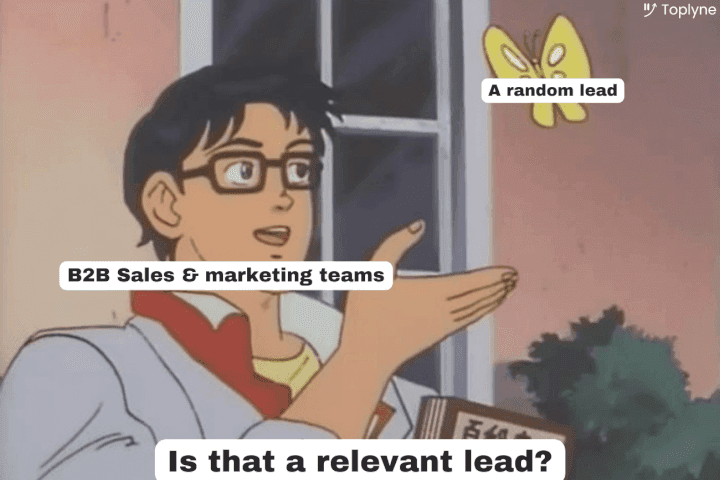What Is B2B Lead Scoring? (Benefits, Models & Best Practices)
What Is B2B Lead Scoring? (Benefits, Models & Best Practices)
What Is B2B Lead Scoring? (Benefits, Models & Best Practices)
Explore B2B lead scoring – when to use it, its key benefits, the scoring systems, and best practices. Also, check out a handy tool to recognize the best PQLs.
Explore B2B lead scoring – when to use it, its key benefits, the scoring systems, and best practices. Also, check out a handy tool to recognize the best PQLs.
Explore B2B lead scoring – when to use it, its key benefits, the scoring systems, and best practices. Also, check out a handy tool to recognize the best PQLs.



Securing many leads is a crucial goal for any B2B company.
But hang on, not all leads are born equal. ⚖️
A lead who clicks the ‘Sign Up’ button on your website is more valuable than one who’s still researching your product.
Now, if only there was an easy way to spot those valuable leads and identify where they’re in the buying cycle. 🧐

Oh, but there is!
It’s a process called lead scoring, and we’ll tell you all about it.
In this article, we’ll delve into B2B lead scoring, when to use it, its four key benefits, and the four different types of lead scoring systems.
Additionally, we’ll discuss five effective B2B lead scoring best practices and share a handy tool that helps you find the most promising leads.
Let’s dive in!
What is B2B Lead Scoring?
B2B lead scoring is a method to identify which leads are most likely to buy your product.
It involves assigning scores (a positive or negative score) to your leads based on their characteristics and behaviors.
A positive score indicates your lead is a decent prospect likely to convert, while a negative score indicates that they’re not a great prospect…at least not yet.
You can assign these scores based on attributes like company size, location, product engagement, etc.
For example, a lead may score +10 points for liking one of your social media posts but lose -20 points for unsubscribing from your newsletter.
Fortunately, you don’t have to figure out the scoring system alone.
With a nifty tool like Toplyne, you can easily spot and nurture high-intent users who are ready to convert. (More on this later!)
Want to boost your marketing efforts and convert your free users into paying customers?
Here are 6 fantastic tips to boost your conversion strategy.
But back to the B2B lead scoring model.
Let’s go over some fundamentals first.
The Key Components of a Robust B2B Lead Scoring Model
You’ll need to handle multiple data points to develop an effective B2B lead scoring model.
But remember B2B is less about individual lead generation and more about account-focused leads.
This is why you need to know all about account scoring.

Nope! Not that kind of account.
While lead scoring ranks individuals on their likelihood of becoming customers, account scoring ranks companies on their probability of converting into customers.
Why is this distinction important?
B2B purchase decisions rely on company finances and stakeholders’ interests and rarely on individual choices.
With that in mind, these are some data points that would help you score leads:
Demographic Data: This data is an aggregation of the details about the individuals evaluating your product. This lead generation data point includes demographic information like job role, seniority, or location of the individual.
Since B2B companies deal exclusively with other companies instead of individuals, demographic data isn’t of primary importance.
Firmographic Data: Unlike demographic data, firmographic data is more broad-based and covers details about your leads’ organizations, e.g., their company size, revenue, industry, and so on.
Given the nature of B2B (involving firms rather than consumers), firmographic data is critical to a B2B lead scoring process.
Attribution Data: This data point value tells you which channel is most successful in lead qualification.
For example, if an online webinar brings in more sales-ready prospects than a stall at an event, the webinar is a more effective channel to drive sales.
Behavioral Data: This data tracks the actions a prospect takes while interacting with your product. For instance, if you want to gauge the success of a new feature on your app, behavioral data helps you track which leads use the new feature and which ones don’t.
Sales/CRM Data: CRM data typically involves marketing, sales, or customer support logs used for lead qualification and lead nurturing.
But before you bring out your red marker for scoring all those leads and accounts, let’s explore:
When Should You Use B2B Lead Scoring?
Of course, B2B lead scoring isn’t necessary for every company.
If your company handles just a handful of leads per month, you’ll do just fine without lead scoring.
Because evaluating each lead or prospect —

But you do need lead scoring if you:
Process a large number of leads every month and need to run an efficient sales system
Regularly deal with several unqualified lead groups and want to go home in time just this once 😅
Frequently miss out on quality leads due to an inability to prioritize
Still skeptical?
Let’s look at the major advantages of B2B lead scoring.
Three Biggest Benefits of B2B Lead Scoring
Your experience in the B2B game has taught you a thing or two about hard sells.
But this isn’t going to be one of those.😎
Here are four super convincing reasons to try your hand at B2B lead scoring:
1. Improved conversion rates
Lead scoring affords you the luxury of being picky on which lead or prospect you dedicate your marketing efforts to.
For instance, your B2B sales team can only speak to leads scoring higher than 60.
And for those with lower scores?
Offer them a free trial to meet your lead nurturing targets.
2. Reduced acquisition costs
With B2B lead scoring, you can prioritize leads with a higher point value, who are more likely to convert, instead of wasting resources on every prospect. This saves a ton of time and money.
Another core element of any sales strategy is re-engaging prospects who may have yet to convert the first time.
B2B lead scoring helps you identify the most high-value ones among this selection, saving you the effort of re-engaging with low-value prospects.
3. Better Sales Forecasting
Once you develop a strategy to score product-qualified leads, you can craft a blueprint to forecast better sales opportunities.
Sales forecasting involves estimating your future revenue generated by sales within a specific period, like a month, quarter, or year. Not only does it make your budget planning smoother, but it also helps optimize your resource usage.
No more laggard growth and cash flow issues! 🤸
Want to know how your SaaS enterprise is performing?
Check out these 12 critical B2B growth metrics to track your company’s performance.
So, how do you implement an effective scoring mechanism?
You can use a B2B lead scoring model to rate your leads and categorize them. Let’s check out some of these lead scoring models.
Two Key Types of B2B Lead Scoring Models
Here are the four predominant B2B lead scoring models you can adopt:
1. Rule-Based Lead Scoring (Manual Lead Scoring)
With this lead scoring system, you manually establish rules on which you score your leads. Your lead scoring software will reward or deduct points from the lead score every time a lead triggers a rule.
You can frame rules based on your leads' positive or negative scoring, which lets you trigger workflows once they secure a minimum threshold lead score.
But what rules should you use in a manual lead scoring system?
The rules you set up would depend on the specific qualities of your marketing and sales funnel. They may include signing up for a free trial, meeting daily active user conditions, using beta features, etc.
In other words, the manual lead scoring system will pick up on any action that indicates a user’s intent to buy (or abandon) your product. However, you’ll have to specify to your software exactly what these indicators should be.
And that’s why this model isn’t ideal. You must manually identify the attributes leading to a high lead score and assign points to them. It relies on the manual monitoring of lead activity, which leaves room for error and misinterpretation.
2. Predictive Lead Scoring (Automated Lead Scoring)
We know you don’t like to leave things to destiny.
But predictive lead scoring is less incense sticks and tarot cards and more AI, algorithms, and lead scoring software!
This self-learning lead scoring system analyzes your past customer patterns to predict when a warm lead will likely make a purchase.
Also called automated lead scoring, the predictive scoring process will autonomously identify the best leads without straining your sales team.
The best part?
The more data your predictive scoring algorithm collects, the greater the accuracy of its predictions.

Let’s look at some lead scoring best practices you can adopt for your business.
Three B2B Lead Scoring Best Practices to Adopt Today
Here are the top five lead scoring best practices to gain outstanding leads for your B2B organization:
1. Set Up Your Tracking
A buyer persona helps you better understand your customers, personalize their experience with your product, and even guide future product developments.
But gathering relevant information about who you're selling to is crucial to building a reliable buyer persona.
And how do you do this?
By keeping a close eye on product usage data like the number of times a user viewed your premium pricing page.
How do you get this sorta data?
Set up your product analytics tools to gather relevant information about user actions in your product. Then take your usage intelligence a step further by setting up a tool like Toplyne on top of your product analytics! A PLS tool like Toplyne leverages data from your product analytics apps to build a pipeline of product-qualified leads for you! 😉
You can also gain crucial product usage and firmographic data by offering a free trial. So make sure you have one!
And of course, you can also go the traditional route and collect data in exchange for a resource like a weekly newsletter, webinar, or tutorial.
But don’t stalk your prospect on social media. 🥸
No one’s doing business with the Joe Goldbergs of the world.

2. Start with a Simple Scoring System and Scale Up from There
While lead scoring helps you identify high-intent users, rushing to set up a complicated scoring model might backfire. Instead, it’s better to start small with just a few scoring criteria in place and scale up as your company grows.
Some best practices in this regard are:
Set up 3 to 5 score triggers crucial to your sales cycle. If you offer a SaaS product, you could assign scores for actions that leads take on your app.
Establish a simple scoring system for easy calculation. For instance, once a lead triggers a positive action, assign a score of 5 points instead of using complicated decimal or fractional scores.
Keep reviewing your scoring system to ensure it’s functional, and add updates whenever needed.
3. Act on Each Lead’s Potential with Toplyne
Finding a sales qualified lead can be challenging when done manually.
Moreover, positive or negative scoring isn't enough; you also want to convert a warm lead into a paying, repeat customer.
Enter Toplyne!
It’s not just a B2B lead scoring tool. Say hello to the sleekest headless sales AI in town!
Any B2B product-led growth (PLG) company can build a smooth, high-functioning pipeline of product-qualified leads and increase its win rate using Toplyne.
Toplyne helps you identify patterns of the most likely-to-convert leads and replicate strategies across your pipeline. Observe the in-app behavior of each sales qualified lead and know when they’re ready to convert.
But that’s not all!
Here’s a quick look at how companies like Canva and Vercel boost their product-led revenue:
Step 1/7: Create monetization playbooks to surface conversion and expansion opportunities (leads most likely to convert to paying customers, and teams most likely to grow into larger teams)

Step 2/7: Choose the right leads to target – users (individual users) or accounts (a group of users with an organization).

Step 3/7: Select the frequency at which you would want leads synced in your GTM apps.

Step 4/7: Define how many leads you want by either the number of leads or your expected win rate, depending on your sales capacity and GTM strategy.

Step 5/7: Build custom segments - Build custom segments based on And/Or logic at the deepest level of sub-properties within your product analytics.

Step 6/7: Validate your GTM strategy - Hold back some users as a control group to test your GTM strategy.

Step 7/7: Sync your product qualified pipeline into your GTM destinations - CRMs, sales & marketing execution tools, and customer engagement platforms.

Catch More Sales Ready B2B Leads with Toplyne
We get it. It’s not easy to pitch to B2B customers.
Here’s our advice:
Be picky!
A B2B lead scoring tool lets you identify customers and accounts that are the best prospects for your product. Once you spot them, you can shower them with all your attention — and pitches! 🤓
Want to cement the connection even further?
Use Toplyne’s PLG mastery to target them with new feature updates, discounts, and much more to reel them in!
The result? A B2B customer base that keeps coming back for more. 😍
To build a sales funnel of product-qualified leads with confidence, sign up with Toplyne today and watch high-intent leads pour in!

Securing many leads is a crucial goal for any B2B company.
But hang on, not all leads are born equal. ⚖️
A lead who clicks the ‘Sign Up’ button on your website is more valuable than one who’s still researching your product.
Now, if only there was an easy way to spot those valuable leads and identify where they’re in the buying cycle. 🧐

Oh, but there is!
It’s a process called lead scoring, and we’ll tell you all about it.
In this article, we’ll delve into B2B lead scoring, when to use it, its four key benefits, and the four different types of lead scoring systems.
Additionally, we’ll discuss five effective B2B lead scoring best practices and share a handy tool that helps you find the most promising leads.
Let’s dive in!
What is B2B Lead Scoring?
B2B lead scoring is a method to identify which leads are most likely to buy your product.
It involves assigning scores (a positive or negative score) to your leads based on their characteristics and behaviors.
A positive score indicates your lead is a decent prospect likely to convert, while a negative score indicates that they’re not a great prospect…at least not yet.
You can assign these scores based on attributes like company size, location, product engagement, etc.
For example, a lead may score +10 points for liking one of your social media posts but lose -20 points for unsubscribing from your newsletter.
Fortunately, you don’t have to figure out the scoring system alone.
With a nifty tool like Toplyne, you can easily spot and nurture high-intent users who are ready to convert. (More on this later!)
Want to boost your marketing efforts and convert your free users into paying customers?
Here are 6 fantastic tips to boost your conversion strategy.
But back to the B2B lead scoring model.
Let’s go over some fundamentals first.
The Key Components of a Robust B2B Lead Scoring Model
You’ll need to handle multiple data points to develop an effective B2B lead scoring model.
But remember B2B is less about individual lead generation and more about account-focused leads.
This is why you need to know all about account scoring.

Nope! Not that kind of account.
While lead scoring ranks individuals on their likelihood of becoming customers, account scoring ranks companies on their probability of converting into customers.
Why is this distinction important?
B2B purchase decisions rely on company finances and stakeholders’ interests and rarely on individual choices.
With that in mind, these are some data points that would help you score leads:
Demographic Data: This data is an aggregation of the details about the individuals evaluating your product. This lead generation data point includes demographic information like job role, seniority, or location of the individual.
Since B2B companies deal exclusively with other companies instead of individuals, demographic data isn’t of primary importance.
Firmographic Data: Unlike demographic data, firmographic data is more broad-based and covers details about your leads’ organizations, e.g., their company size, revenue, industry, and so on.
Given the nature of B2B (involving firms rather than consumers), firmographic data is critical to a B2B lead scoring process.
Attribution Data: This data point value tells you which channel is most successful in lead qualification.
For example, if an online webinar brings in more sales-ready prospects than a stall at an event, the webinar is a more effective channel to drive sales.
Behavioral Data: This data tracks the actions a prospect takes while interacting with your product. For instance, if you want to gauge the success of a new feature on your app, behavioral data helps you track which leads use the new feature and which ones don’t.
Sales/CRM Data: CRM data typically involves marketing, sales, or customer support logs used for lead qualification and lead nurturing.
But before you bring out your red marker for scoring all those leads and accounts, let’s explore:
When Should You Use B2B Lead Scoring?
Of course, B2B lead scoring isn’t necessary for every company.
If your company handles just a handful of leads per month, you’ll do just fine without lead scoring.
Because evaluating each lead or prospect —

But you do need lead scoring if you:
Process a large number of leads every month and need to run an efficient sales system
Regularly deal with several unqualified lead groups and want to go home in time just this once 😅
Frequently miss out on quality leads due to an inability to prioritize
Still skeptical?
Let’s look at the major advantages of B2B lead scoring.
Three Biggest Benefits of B2B Lead Scoring
Your experience in the B2B game has taught you a thing or two about hard sells.
But this isn’t going to be one of those.😎
Here are four super convincing reasons to try your hand at B2B lead scoring:
1. Improved conversion rates
Lead scoring affords you the luxury of being picky on which lead or prospect you dedicate your marketing efforts to.
For instance, your B2B sales team can only speak to leads scoring higher than 60.
And for those with lower scores?
Offer them a free trial to meet your lead nurturing targets.
2. Reduced acquisition costs
With B2B lead scoring, you can prioritize leads with a higher point value, who are more likely to convert, instead of wasting resources on every prospect. This saves a ton of time and money.
Another core element of any sales strategy is re-engaging prospects who may have yet to convert the first time.
B2B lead scoring helps you identify the most high-value ones among this selection, saving you the effort of re-engaging with low-value prospects.
3. Better Sales Forecasting
Once you develop a strategy to score product-qualified leads, you can craft a blueprint to forecast better sales opportunities.
Sales forecasting involves estimating your future revenue generated by sales within a specific period, like a month, quarter, or year. Not only does it make your budget planning smoother, but it also helps optimize your resource usage.
No more laggard growth and cash flow issues! 🤸
Want to know how your SaaS enterprise is performing?
Check out these 12 critical B2B growth metrics to track your company’s performance.
So, how do you implement an effective scoring mechanism?
You can use a B2B lead scoring model to rate your leads and categorize them. Let’s check out some of these lead scoring models.
Two Key Types of B2B Lead Scoring Models
Here are the four predominant B2B lead scoring models you can adopt:
1. Rule-Based Lead Scoring (Manual Lead Scoring)
With this lead scoring system, you manually establish rules on which you score your leads. Your lead scoring software will reward or deduct points from the lead score every time a lead triggers a rule.
You can frame rules based on your leads' positive or negative scoring, which lets you trigger workflows once they secure a minimum threshold lead score.
But what rules should you use in a manual lead scoring system?
The rules you set up would depend on the specific qualities of your marketing and sales funnel. They may include signing up for a free trial, meeting daily active user conditions, using beta features, etc.
In other words, the manual lead scoring system will pick up on any action that indicates a user’s intent to buy (or abandon) your product. However, you’ll have to specify to your software exactly what these indicators should be.
And that’s why this model isn’t ideal. You must manually identify the attributes leading to a high lead score and assign points to them. It relies on the manual monitoring of lead activity, which leaves room for error and misinterpretation.
2. Predictive Lead Scoring (Automated Lead Scoring)
We know you don’t like to leave things to destiny.
But predictive lead scoring is less incense sticks and tarot cards and more AI, algorithms, and lead scoring software!
This self-learning lead scoring system analyzes your past customer patterns to predict when a warm lead will likely make a purchase.
Also called automated lead scoring, the predictive scoring process will autonomously identify the best leads without straining your sales team.
The best part?
The more data your predictive scoring algorithm collects, the greater the accuracy of its predictions.

Let’s look at some lead scoring best practices you can adopt for your business.
Three B2B Lead Scoring Best Practices to Adopt Today
Here are the top five lead scoring best practices to gain outstanding leads for your B2B organization:
1. Set Up Your Tracking
A buyer persona helps you better understand your customers, personalize their experience with your product, and even guide future product developments.
But gathering relevant information about who you're selling to is crucial to building a reliable buyer persona.
And how do you do this?
By keeping a close eye on product usage data like the number of times a user viewed your premium pricing page.
How do you get this sorta data?
Set up your product analytics tools to gather relevant information about user actions in your product. Then take your usage intelligence a step further by setting up a tool like Toplyne on top of your product analytics! A PLS tool like Toplyne leverages data from your product analytics apps to build a pipeline of product-qualified leads for you! 😉
You can also gain crucial product usage and firmographic data by offering a free trial. So make sure you have one!
And of course, you can also go the traditional route and collect data in exchange for a resource like a weekly newsletter, webinar, or tutorial.
But don’t stalk your prospect on social media. 🥸
No one’s doing business with the Joe Goldbergs of the world.

2. Start with a Simple Scoring System and Scale Up from There
While lead scoring helps you identify high-intent users, rushing to set up a complicated scoring model might backfire. Instead, it’s better to start small with just a few scoring criteria in place and scale up as your company grows.
Some best practices in this regard are:
Set up 3 to 5 score triggers crucial to your sales cycle. If you offer a SaaS product, you could assign scores for actions that leads take on your app.
Establish a simple scoring system for easy calculation. For instance, once a lead triggers a positive action, assign a score of 5 points instead of using complicated decimal or fractional scores.
Keep reviewing your scoring system to ensure it’s functional, and add updates whenever needed.
3. Act on Each Lead’s Potential with Toplyne
Finding a sales qualified lead can be challenging when done manually.
Moreover, positive or negative scoring isn't enough; you also want to convert a warm lead into a paying, repeat customer.
Enter Toplyne!
It’s not just a B2B lead scoring tool. Say hello to the sleekest headless sales AI in town!
Any B2B product-led growth (PLG) company can build a smooth, high-functioning pipeline of product-qualified leads and increase its win rate using Toplyne.
Toplyne helps you identify patterns of the most likely-to-convert leads and replicate strategies across your pipeline. Observe the in-app behavior of each sales qualified lead and know when they’re ready to convert.
But that’s not all!
Here’s a quick look at how companies like Canva and Vercel boost their product-led revenue:
Step 1/7: Create monetization playbooks to surface conversion and expansion opportunities (leads most likely to convert to paying customers, and teams most likely to grow into larger teams)

Step 2/7: Choose the right leads to target – users (individual users) or accounts (a group of users with an organization).

Step 3/7: Select the frequency at which you would want leads synced in your GTM apps.

Step 4/7: Define how many leads you want by either the number of leads or your expected win rate, depending on your sales capacity and GTM strategy.

Step 5/7: Build custom segments - Build custom segments based on And/Or logic at the deepest level of sub-properties within your product analytics.

Step 6/7: Validate your GTM strategy - Hold back some users as a control group to test your GTM strategy.

Step 7/7: Sync your product qualified pipeline into your GTM destinations - CRMs, sales & marketing execution tools, and customer engagement platforms.

Catch More Sales Ready B2B Leads with Toplyne
We get it. It’s not easy to pitch to B2B customers.
Here’s our advice:
Be picky!
A B2B lead scoring tool lets you identify customers and accounts that are the best prospects for your product. Once you spot them, you can shower them with all your attention — and pitches! 🤓
Want to cement the connection even further?
Use Toplyne’s PLG mastery to target them with new feature updates, discounts, and much more to reel them in!
The result? A B2B customer base that keeps coming back for more. 😍
To build a sales funnel of product-qualified leads with confidence, sign up with Toplyne today and watch high-intent leads pour in!

Related Articles




Behavioral Retargeting: A Game-Changer in the Cookieless Era
Unlock the power of behavioral retargeting for the cookieless future! Learn how it personalizes ads & boosts conversions. #behavioralretargeting




All of Toplyne's 40+ Badges in the G2 Spring Reports
Our customers awarded us 40+ badges in G2's Summer Report 2024.




Unlocking the Full Potential of Google PMax Campaigns: Mastering Audience Selection to Double Your ROAS
Copyright © Toplyne Labs PTE Ltd. 2024
Copyright © Toplyne Labs PTE Ltd. 2024
Copyright © Toplyne Labs PTE Ltd. 2024
Copyright © Toplyne Labs PTE Ltd. 2024